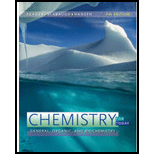
Concept explainers
A sample of gas weighs
Interpretation:
The molecular weight of the given gas is to be calculated. Whether the given sample of gas is
Concept introduction:
The ideal gas equation is used to represent the relation between the volume, pressure, temperature and number of moles of an ideal gas. The ideal gas equation is given as,
Where,
•
•
•
•
•
Answer to Problem 6.56E
The molecular mass of gas is
Explanation of Solution
The pressure of the given gas is
The temperature of the given gas is
The temperature of the given gas in Kelvin is represented as,
It is given that a sample of the given gas has a mass of
The given volume of the given gas is
The molar mass of
The molar mass of
The molar mass of
The ideal gas equation is given as,
Where,
•
•
•
•
•
Rearrange the above equation for the value of
Substitute the value of
Therefore, the number of moles of the given gas is
The relation between mass and number of moles of a substance is given as,
Where,
•
•
•
Substitute the value of mass and number of moles of the given gas in the equation (2).
The molar mass of given gas is
Therefore, the molecular mass of gas is
The molecular mass of gas is
Want to see more full solutions like this?
Chapter 6 Solutions
Chemistry For Today: General, Organic, And Biochemistry, Loose-leaf Version
Additional Science Textbook Solutions
Basic Chemistry (5th Edition)
Organic Chemistry As a Second Language: Second Semester Topics
Organic Chemistry
Principles of Chemistry: A Molecular Approach (3rd Edition)
Fundamentals of Heat and Mass Transfer
Organic Chemistry (9th Edition)
- Given that a sample of air is made up of nitrogen, oxygen, and argon in the mole fractions 0.78 N2, 0.21 O2, and 0.010 Ar, what is the density of air at standard temperature and pressure?arrow_forwardGiven that a sample of air is made up of nitrogen, oxygen, and argon in the mole fractions 0.78 N2, 0.21 O2, and 0.010 Ar, what is the density of air at standard temperature and pressure?arrow_forwardYou have an equimolar mixture of the gases SO2 and O2, along with some He, in a container fitted with a piston. The density of this mixture at STP is 1.924 g/L. Assume ideal behavior and constant temperature and pressure. a. What is the mole fraction of He in the original mixture? b. The SO2 and O2 react to completion to form SO3. What is the density of the gas mixture after the reaction is complete?arrow_forward
- Sulfur trioxide, SO3, is produced in enormous quantities each year for use in the synthesis of sulfuric acid. S(s)+O2(g)SO2(g)2SO2(g)+O2(g)2SO3(g) What volume of O2(g) at 350.C and a pressure of 5.25 atm is needed to completely convert 5.00 g sulfur to sulfur trioxide?arrow_forwardA sample of a smoke stack emission was collected into a 1.25-L tank at 752 mm Hg and analyzed. The analysis showed 92% CO2, 3.6% NO, 1.2% SO2, and 4.1% H2O by mass. What is the partial pressure exerted by each gas?arrow_forwardYou have two pressure-proof steel cylinders of equal volume, one containing 1.0 kg of CO and the other containing 1.0 kg of acetylene, C2H2. (a) In which cylinder is the pressure greater at 25 C? (b) Which cylinder contains the greater number of molecules?arrow_forward
 Chemistry: Principles and PracticeChemistryISBN:9780534420123Author:Daniel L. Reger, Scott R. Goode, David W. Ball, Edward MercerPublisher:Cengage Learning
Chemistry: Principles and PracticeChemistryISBN:9780534420123Author:Daniel L. Reger, Scott R. Goode, David W. Ball, Edward MercerPublisher:Cengage Learning Chemistry: The Molecular ScienceChemistryISBN:9781285199047Author:John W. Moore, Conrad L. StanitskiPublisher:Cengage Learning
Chemistry: The Molecular ScienceChemistryISBN:9781285199047Author:John W. Moore, Conrad L. StanitskiPublisher:Cengage Learning
 ChemistryChemistryISBN:9781305957404Author:Steven S. Zumdahl, Susan A. Zumdahl, Donald J. DeCostePublisher:Cengage Learning
ChemistryChemistryISBN:9781305957404Author:Steven S. Zumdahl, Susan A. Zumdahl, Donald J. DeCostePublisher:Cengage Learning Chemistry: An Atoms First ApproachChemistryISBN:9781305079243Author:Steven S. Zumdahl, Susan A. ZumdahlPublisher:Cengage Learning
Chemistry: An Atoms First ApproachChemistryISBN:9781305079243Author:Steven S. Zumdahl, Susan A. ZumdahlPublisher:Cengage Learning Chemistry: Principles and ReactionsChemistryISBN:9781305079373Author:William L. Masterton, Cecile N. HurleyPublisher:Cengage Learning
Chemistry: Principles and ReactionsChemistryISBN:9781305079373Author:William L. Masterton, Cecile N. HurleyPublisher:Cengage Learning





